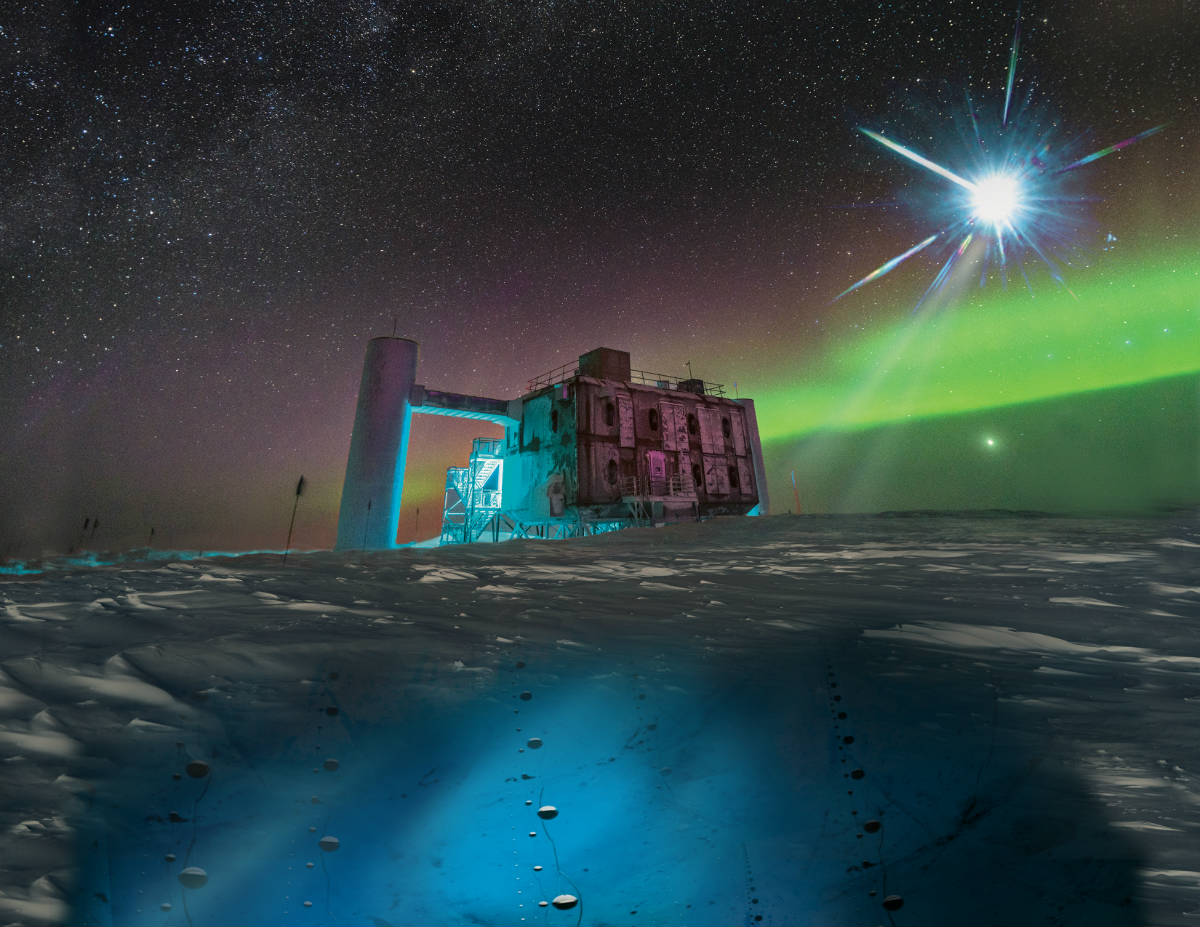
In this artistic rendering, based on a real image of the IceCube Lab at the South Pole, a distant source emits neutrinos that are detected below the ice by IceCube sensors, called DOMs. Credit: Icecube/NSF
An international team of scientists has found the first evidence of a source of high-energy cosmic neutrinos, ghostly subatomic particles that can travel unhindered for billions of light years from the most extreme environments in the Universe to Earth. The observation of a neutrino from a blazar-a giant elliptical galaxy with a massive, rapidly spinning black hole at its core, designated TXS 0506+056-was made on September 22, 2017 at the IceCube Neutrino Observatory at the South Pole.
The announcement for the landmark discovery, marked by two papers published today in the prestigious peer-reviewed journal Science, was made this morning by the international IceCube collaboration at the National Science Foundation in Washington. Marking the magnitude of the discovery, there are several follow-up observations detailed in a half dozen papers in addition to the two Science papers.
"These intriguing results represent the remarkable culmination of thousands of human years of intensive activities by the IceCube Collaboration to bring the dream of neutrino astronomy to reality," said Darren Grant, IceCube spokesperson and UAlberta physics professor and Canada Research Chair in Astroparticle Physics, speaking of the international team with more than 300 scientists from 12 countries.
The discovery unites two areas of research strength at the University of Alberta, astrophysics and particle physics. Grant's colleagues and fellow physics professors Claudio Kopper and Gregory Sivakoff, along with their graduate students, played instrumental roles in the discovery, Kopper with a focus on neutrinos and Sivakoff with an eye on astronomy.
"This whole project is an interesting mix of scientists whose work together began through things like the IceCube Alerts and Astronomer's Telegrams and progressed to an impressive collaboration of facilities working together on one paper. We're witnessing the benefit of combining the talents of astrophysicists and particle physicists, combining not only photon detection but also new messengers such as astrophysical neutrinos, like the one announced in today's discovery," said Sivakoff. Sivakoff's PhD student, Alexandra Tetarenko, converted radio observations into some of the measured data reported in the primary publication in Science. "It's truly humbling to be part of such a revolution in the field. There will be some growing pains, but in the end, the best combination of the two will likely emerge to better shape our view of the Universe."
For Kopper's part, as lead of the "diffuse neutrino flux" working group for IceCube, responsible for the detailed follow-up reconstruction system that provided the initial input used by all of the analyses for the new discovery, he emphasized that time is most definitely of the essence when tracking something traveling billions of light years.
"We had to run detailed reconstructions of the neutrino event direction as fast as possible before sending the alert from IceCube to all of its partners," said Kopper. "We were only able to do that so quickly because we had access to the Canada Foundation for Innovation-funded GPU-computing cluster 'illume,' made here at the University of Alberta, which allowed us to accelerate the necessary computations."
In addition to Kopper and Grant, UAlberta physics professors Roger Moore and Juan Pablo Yáñez are also members of the IceCube collaboration, four of only five scientists from Canadian universities.